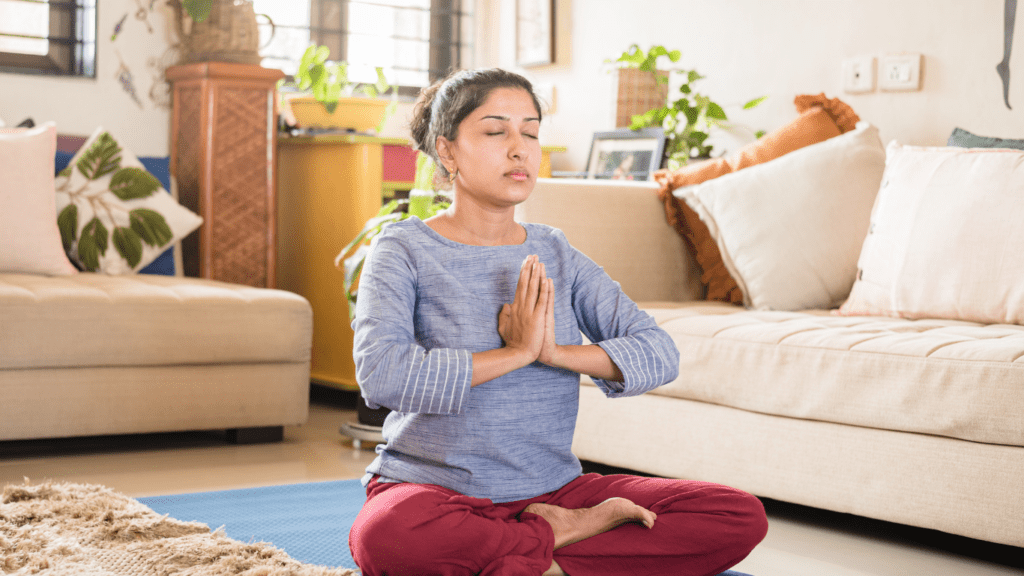Choosing the Right Location
Selecting the optimal spot for meditation can significantly impact your practice’s effectiveness and tranquility.
Assessing Natural Light
Natural light enhances a meditation space by creating a soothing atmosphere. Place your meditation area near a window that receives indirect sunlight. Too much direct light can be harsh, so diffuse it with sheer curtains or blinds. Avoid basements or rooms without windows, as they can feel enclosed and less inviting.
Considering Noise Levels
Low noise levels are essential for maintaining concentration during meditation. Choose a location away from busy streets, noisy appliances, or commonly used rooms. If external sounds are unavoidable, consider using a white noise machine or soft background music to drown out disturbances. Thick rugs, curtains, and cushions also absorb sound, creating a quieter environment.
Selecting Comfortable Furniture
Choosing the right furniture for your meditation space creates a comfortable and inviting environment conducive to relaxation. Comfort is key to maintaining focus and achieving a deeper meditative state.
Cushions and Seating
Selecting proper cushions and seating is crucial for comfort during meditation. A well-cushioned chair, meditation bench, or floor cushions can help maintain proper posture and reduce discomfort.
Round cushions (zafus), floor cushions (zabutons), and benches specifically designed for meditation provide support and encourage alignment. I recommend using a variety of cushions to accommodate different sitting positions, such as cross-legged or kneeling postures.
Mats and Rugs
Incorporating mats and rugs adds comfort and warmth to your meditation space. Soft, durable mats provide a layer between you and the floor, enhancing comfort during extended meditation sessions.
Rugs contribute to the aesthetic appeal of the space while offering additional padding. I suggest choosing natural fiber rugs for a more organic and grounding feel. Consider the color and texture to ensure it complements the overall ambiance of the meditation area.
Incorporating Soothing Elements

Creating a calm and peaceful meditation space involves infusing it with elements that promote tranquility. Selections like essential oils and greenery can significantly enhance the atmosphere.
Essential Oils and Diffusers
Use essential oils to fill the space with calming scents. Lavender, chamomile, and eucalyptus promote relaxation. Diffusers distribute these scents evenly. Choose ultrasonic diffusers; they don’t use heat and preserve the oils’ benefits. Set the diffuser up in a corner where it’s unobtrusive but effective.
Plants and Greens
Include plants to bring nature indoors. Snake plants, peace lilies, and aloe vera purify the air and add a soothing visual element. Place larger plants in corners and smaller ones on shelves or windowsills. Ensure they complement the overall design and don’t clutter the space. Regular care maintains their health and the room’s ambiance.
Creating the Right Ambiance
Setting the right ambiance is essential for an effective meditation space. The environment should promote relaxation and focus.
Lighting Options
Selecting appropriate lighting enhances the calmness of the space. Soft, warm lights create a soothing atmosphere. For instance, dimmable LED bulbs allow control over brightness levels. Salt lamps emit a gentle glow and purify the air. Placing candles strategically around the room adds an element of tranquility, making the space more inviting for meditation.
Sound and Music
- Incorporating sound elements helps maintain focus during meditation sessions.
- Nature sounds, like flowing water or chirping birds, create a peaceful background.
- White noise machines mask distracting sounds, enhancing concentration.
- Playing soft instrumental music, such as Tibetan singing bowls or wind chimes, further contributes to a serene atmosphere.
- Integrating these sounds thoughtfully transforms the meditation space into a sanctuary of calm.
Personalizing Your Meditation Space
Creating a meditation space tailored to your preferences enhances tranquility and focus.
Inspirational Decor
Adding personal, inspirational decor can elevate your meditation space. Consider wall art, quotes, or statues that resonate with your spiritual beliefs or personal values.
For instance, a Buddha statue or a framed quote that inspires peace can have a profound impact. Choose colors that calm your mind; shades like blues, greens, and neutrals often work best. Plants like bonsai trees or succulents can add a touch of nature and harmony. Use small, balanced elements rather than cluttering the space.
Organizing Meditation Tools
Keeping meditation tools organized ensures a seamless practice. Use trays, baskets, or shelves to neatly store items like:
- singing bowls
- incense
- prayer beads
Having everything in its place fosters a sense of order and readiness. If you use a meditation journal, keep it within easy reach, perhaps on a small table or shelf. Maintain easy access to essential oils or any small items that aid your meditation. An uncluttered space eliminates distractions and enhances the overall meditation experience.
 Albert Newman has been a dedicated contributor to Top Wellness Activity Hub, leveraging his extensive background in digital content creation to enrich the platform with engaging and valuable information. Known for his meticulous research and a knack for simplifying complex wellness topics, Albert focuses on producing content that is both informative and approachable. His articles cover a broad spectrum of wellness subjects, from healthy eating habits to the latest trends in yoga and fitness. Albert's ability to break down intricate health concepts into easily digestible insights has made the platform a trusted source for wellness advice.
Beyond his writing, Albert is also deeply involved in the content strategy and editorial planning of the platform. His collaborative approach ensures that each piece of content aligns with the platform’s mission to empower users on their wellness journey. Albert is always exploring innovative ways to engage readers, whether through interactive guides or personalized wellness tips. His commitment to creating high-quality, reader-centric content plays a significant role in the platform’s ongoing success.
Albert Newman has been a dedicated contributor to Top Wellness Activity Hub, leveraging his extensive background in digital content creation to enrich the platform with engaging and valuable information. Known for his meticulous research and a knack for simplifying complex wellness topics, Albert focuses on producing content that is both informative and approachable. His articles cover a broad spectrum of wellness subjects, from healthy eating habits to the latest trends in yoga and fitness. Albert's ability to break down intricate health concepts into easily digestible insights has made the platform a trusted source for wellness advice.
Beyond his writing, Albert is also deeply involved in the content strategy and editorial planning of the platform. His collaborative approach ensures that each piece of content aligns with the platform’s mission to empower users on their wellness journey. Albert is always exploring innovative ways to engage readers, whether through interactive guides or personalized wellness tips. His commitment to creating high-quality, reader-centric content plays a significant role in the platform’s ongoing success.